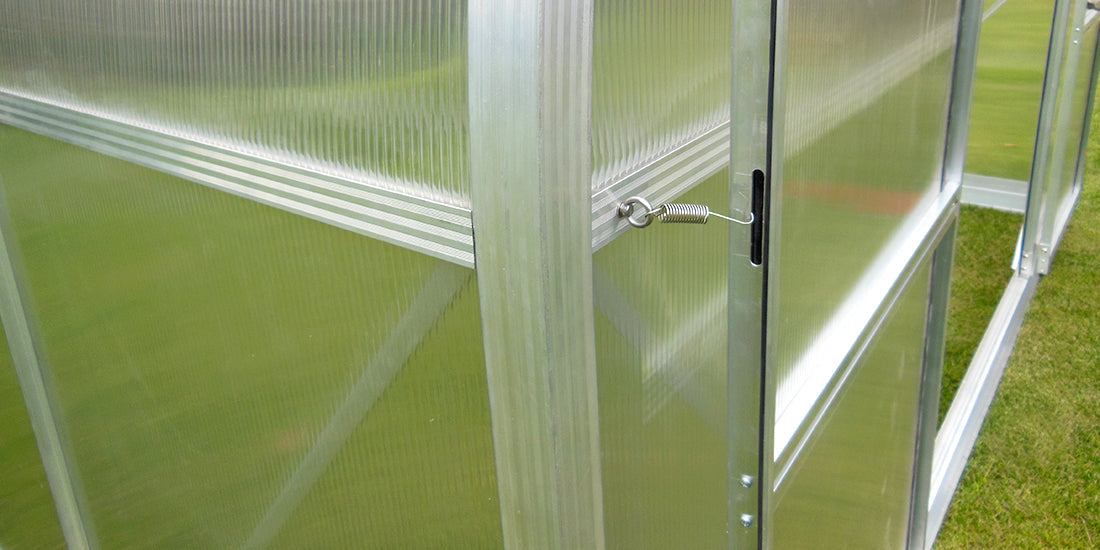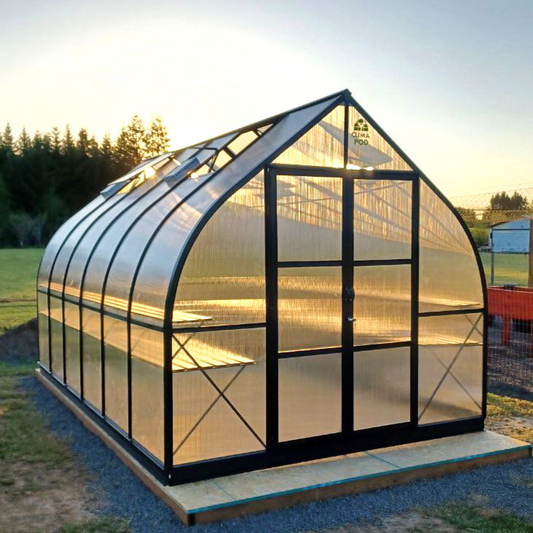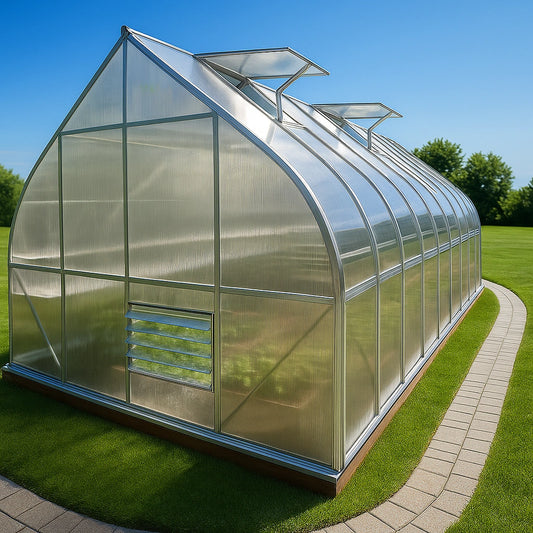
Choosing the Best Polycarbonate for Your Greenhouse
Building a high-quality greenhouse in your backyard requires selecting the right materials. Modern gardeners often prefer polycarbonate, a durable and versatile translucent plastic that has largely replaced traditional glass. To ensure your greenhouse thrives, it's essential to consider the type, thickness, color, and UV protection of the polycarbonate.
Types of Polycarbonate: Monolithic vs. Honeycomb

DIY Polycarbonate Greenhouse
When selecting polycarbonate for your greenhouse, you’ll encounter two main types: monolithic and honeycomb (cellular). Both options have unique benefits, but your choice will depend on your priorities and budget.
Honeycomb Polycarbonate
- Structure: Made of hollow cells with internal walls, resembling a sandwich-like design.
- Lightweight: Approximately 15 times lighter than glass, making it easy to install without additional support structures.
- Flexibility: Ideal for creating curved or uniquely shaped greenhouses.
- Light Transmission: Can transmit up to 86% of light, providing ample natural sunlight for plant growth.
- Durability: Resistant to mechanical stress, weather fluctuations, and does not shatter like glass.
Monolithic Polycarbonate
- Appearance: Solid sheets that closely resemble glass but are significantly stronger.
- Weight: Heavier than honeycomb polycarbonate, which may require sturdier support structures.
- Cost: Generally more expensive due to its aesthetic appeal and higher strength.
- Applications: Best for those prioritizing a sleek and glass-like appearance.
Which to Choose?
Honeycomb polycarbonate is practical and functional, while monolithic polycarbonate is more visually appealing. If your primary goal is efficiency and cost-effectiveness, honeycomb is the better option.
Choosing the Right Thickness for Your Greenhouse
The thickness of polycarbonate sheets is a critical factor in determining their performance and durability.
Available Thicknesses
Polycarbonate sheets range from 4mm to 12mm or more, with each thickness suited for specific applications:
- 4mm Sheets: Lightweight and budget-friendly but prone to deformation. Suitable for mild climates with minimal snow and wind loads.
- 6mm–8mm Sheets: Better for areas with more extreme weather conditions, providing improved insulation and durability.
Factors to Consider
-
Weather Conditions: Evaluate snow and wind loads, as well as temperature fluctuations in your area.
For regions with winters colder than -15°F (-26°C) or summers hotter than 93°F (34°C), choose thicker sheets for better insulation and structural integrity. - Greenhouse Size: Standard greenhouse dimensions (e.g., 3x6m or 3.2x10m) often work well with 4mm–8mm sheets.
- Curvature: Thinner sheets are more flexible, making them ideal for curved greenhouse designs.
Optimal Polycarbonate Colors for Greenhouses

polycarbonate colors
Polycarbonate sheets are available in various colors, but not all are suitable for plant growth.
Best Color Options
- Transparent: Allows up to 90% of sunlight to pass through, making it ideal for most greenhouses.
- Frosted: Transmits 65% of light and prevents plant burns but may hinder photosynthesis slightly.
- Yellow: Offers light transmission of about 72%, suitable for areas with a favorable climate and low wind exposure.
Colors to Avoid
- Blue/Turquoise: Distorts light and does not support photosynthesis effectively.
- Dark Shades (e.g., Green, Red, Brown): Only suitable for specific purposes like growing mushrooms or berries, as they significantly reduce light transmission.
If your greenhouse relies on artificial lighting and heating, you can experiment with colored sheets. However, for most applications, clear or frosted options are the safest choices.
Does Polycarbonate Need UV Protection?

UV-protected polycarbonate
One of the most critical aspects of polycarbonate for greenhouses is UV protection. Prolonged exposure to sunlight can degrade the material, reducing its lifespan and effectiveness.
Types of UV Protection
- Single-Sided Coating: Adequate for most backyard greenhouses.
- Double-Sided Coating: Offers enhanced durability, especially in regions with intense sunlight.
- Integrated UV Protection: A protective layer embedded in the polycarbonate structure, providing long-lasting resistance.
Recommended Standards
The UV protection layer should block 30%–46% of harmful rays.
Always check the product specifications or certification to ensure the material meets these requirements.
Final Thoughts: Selecting the Best Polycarbonate
Choosing the right polycarbonate for your greenhouse involves balancing functionality, durability, and cost. Consider the following:
- Type: Honeycomb for practicality, monolithic for aesthetics.
- Thickness: 4mm–8mm depending on climate and greenhouse design.
- Color: Transparent or frosted for maximum light transmission.
- UV Protection: Essential for long-term performance.
By carefully evaluating these factors, you can create a greenhouse that is not only durable and efficient but also optimized for healthy plant growth.
10mm Honeycomb Polycarbonate: The Perfect Choice for Aluminum Greenhouses
When designing a durable and efficient greenhouse, particularly one with an aluminum frame, 10mm honeycomb (cellular) polycarbonate offers exceptional advantages. This material is ideal for regions with harsh weather conditions and is a reliable option for large or professional-grade greenhouses.
Key Features and Advantages of 10mm Honeycomb Polycarbonate
1. Superior Insulation
The increased thickness of 10mm polycarbonate provides excellent thermal insulation, reducing heat loss during colder months and maintaining stable temperatures inside the greenhouse.
Its multi-layer honeycomb structure creates air pockets that act as an insulating barrier, ideal for maintaining the optimal growing environment.
2. Enhanced Durability
Withstands Harsh Weather: 10mm polycarbonate is highly resistant to wind, snow, and hail. Its thicker walls and robust honeycomb structure ensure stability even under significant loads.
Impact Resistance: Compared to thinner sheets, 10mm polycarbonate can endure higher levels of mechanical stress, making it perfect for areas prone to extreme weather events.
3. Excellent Light Diffusion
The honeycomb structure allows for even light distribution throughout the greenhouse, minimizing shadows and hot spots. This helps plants grow uniformly and reduces the risk of leaf burns.
Transmits approximately 80% of light, ensuring adequate illumination while still protecting plants from excessive sunlight.
4. Compatibility with Aluminum Frames
- Structural Synergy: The lightweight yet sturdy nature of 10mm polycarbonate pairs seamlessly with aluminum greenhouse frames, providing excellent structural integrity.
- Reduced Frame Stress: Despite its thickness, 10mm polycarbonate is lighter than glass, reducing stress on the aluminum frame and increasing the greenhouse’s lifespan.
5. Improved Load-Bearing Capacity
10mm sheets can support higher snow and wind loads compared to 4mm or 6mm sheets, making them ideal for regions with heavy snowfall.
Recommended for professional greenhouses or larger structures where additional strength and insulation are necessary.
Applications of 10mm Honeycomb Polycarbonate in Aluminum Greenhouses
- Cold Climates: Provides superior insulation, making it ideal for areas with severe winters.
- Commercial and Large Greenhouses: Ensures stability and long-term performance for high-investment structures.
- Multi-Season Growing: Perfect for year-round cultivation of fruits, vegetables, and flowers.
- Specialized Crops: Suitable for growing sensitive plants that require consistent temperature and light conditions.
Why Choose 10mm Polycarbonate for Aluminum Greenhouses?
- Energy Efficiency: Reduces heating and cooling costs by maintaining stable internal temperatures.
- Long Lifespan: Offers UV protection and excellent weather resistance, ensuring decades of use without significant wear.
- Professional Quality: Preferred by commercial growers for its balance of strength, durability, and insulation.
Conclusion
For aluminum greenhouses, 10mm honeycomb polycarbonate is an investment in durability, efficiency, and plant health. Its superior insulation, strength, and compatibility with aluminum frames make it the optimal choice for creating a greenhouse that withstands the elements while fostering robust plant growth.
10mm Polycarbonate Titan Greenhouse Kit Series
The ClimaPod Advantage: Premium Greenhouse Kits, Designed for Your Success

ClimaPod Virtue 9×21 Greenhouse Dimensions
Investing in a greenhouse is an investment in your harvest. ClimaPod ensures that investment pays off. Our pre-engineered kits utilize premium, UV-protected 4mm or 6mm polycarbonate panels and a durable, lightweight aluminum frame capable of withstanding up to 12-15 inches of snow. We've meticulously designed each kit (from 7x12 ft to 9x42 ft) for optimal performance and ease of assembly. Forget the hassle of sourcing materials, calculating dimensions, and wrestling with complex designs. ClimaPod delivers quality, convenience, and a guaranteed return on your investment. Explore our kits now!











